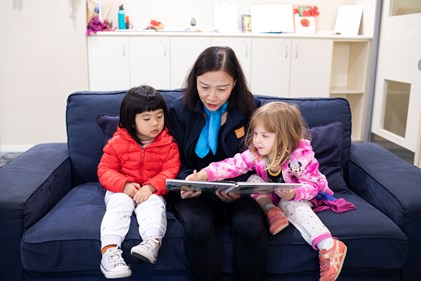How do you choose a good children’s book?
Having access to quality children’s books is a good way for children to begin a lifelong love of reading. Picture books help children develop essential listening and conversation skills, an understanding that words convey meaning, the ability to interpret pictures and an ever-growing vocabulary. These early skills lay an important foundation for independent reading.
But is every book a good book? How do you choose a good children’s book?
There are words all around us, and children will learn to read and write by noticing and decoding many kinds of writing. At the end of the day, any book is a good book if it gets children interested in reading.
For those who want some help picking out the ‘good’ children’s books from the ‘any’ books, there are a few features you can look out for.
- Relatability – a book with a storyline or character that is relatable to children is more likely to engage them. This doesn’t mean that the characters or experiences in the book have to be the same as children’s own experiences, just that something about the story is familiar. Storylines that prompt empathy are highly relatable.
- Aesthetics – the pictures in a picture book are just as important as the words. Children are drawn in by beautiful illustrations and a well-designed layout that keeps them turning pages. Some excellent picture books have no or few words so children can tell the story themselves. Pictures that match or complement the words on the page also help children decode meaning and build their vocabulary.
- The ‘wonder’ factor – good children’s books will have a wonder factor. Maybe there’s magic or adventure in the storyline, maybe it’s the rhythm or rhyme of the words. Silliness, dramatic images, action plays and big feelings can also add the wonder factor.
- Writing and vocabulary – pay attention to the number of words on each page, the writing style and the vocabulary. Will the book make sense to your child? Is the writing clear, rhythmic and consistent? A book with sentences that are too long or have no relationship to the pictures will not keep a child interested long.
- Award winners and classic reads – you can’t go past the Children’s Book Council of Australia’s shortlisted books in either the Early Childhood or Picture Book categories. A winner is chosen each year in a range of categories, but everything on the shortlist is a reliable goodie. And remember, classic books are classics for a reason. https://cbca.org.au/

Quick tips for age groups
Infants
Great books for the youngest of children will be durable (board books or fabric books) and short. Books for babies may not have a narrative but will engage the baby in hide-and-seek or peek-a-boo games, and use pictures of people or animals for relatability. Really great baby books with a storyline will have rhythmic, repetitive, simple language.
Excellent examples – Once I Heard a Little Wombat (Renee Treml), Where is the Green sheep? (Mem Fox), the That’s Not My … Series (Fiona Watt), Hello Baby! (Mem Fox), Hairy Maclary from Donaldson's Dairy (Lynley Dodd), Joey Counts to Ten (Sally Morgan)
Toddlers
Repetition and predictable language make engaging books where toddlers can “read” along with you. Simple storylines with actions or animals that allow toddlers to show off what they know and can do are a hit too. Stories that gently and positively explore feelings or new skills also make good books for toddlers.
Excellent examples – Rosie’s Walk (Pat Hutchins), From Head to Toe (Eric Carle), We’re Going on a Bear Hunt (Michael Rosen), Everybody Poos (Taro Gomi), Foods with Moods (Saxton Freymann and Joost Elffers), Mr McGee (Pamela Allen)
Preschoolers
Preschoolers can sit through long books if they’re well-written and engaging. Stories which capture a child’s imagination and feature people or places that are relatable are more likely to pique a preschooler’s interest. There are a wealth of great books for preschoolers which explore big feelings such as fear, anger or sadness, and can help children make sense of social issues or big life events. A good book for preschoolers will also introduce some complex vocabulary, as pictures and the storyline help children to interpret the meaning of the new word.
Excellent examples – This and That (Mem Fox), Do Not Open This Book (Andy Lee), When Sophie Gets Angry (Molly Bang), The Magic Hat (Mem Fox), Where the Wild Things Are (Maurice Sendak), Big Rain Coming (Katrina Germein), Magic Beach (Alison Lester)
Your child doesn’t need many books to enjoy reading. Many children are happy to read the same great book again and again and again.
If you don’t have many children’s books, head to your council library or Street Library and read together there, or borrow some for home. Pay attention to what your child enjoys and how long they’re able to sit for. Once you work out what works for your child, you can look for other titles with similar features and begin to expand their interests and attention span.
Happy reading!

